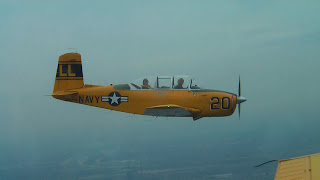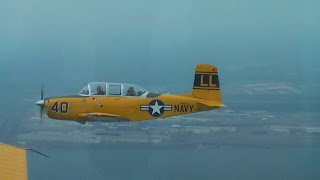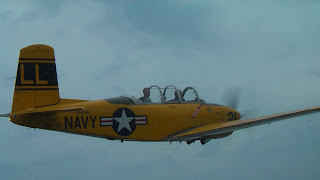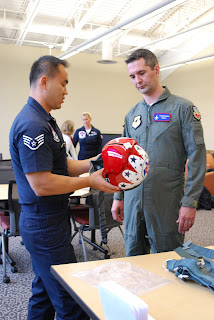Frame Grabs of the Other Media Riders from the T-34 Ride
Capt Force Joins the Glass Mafia

This is a regular blog post. Show notes and links to show audio appear in other posts.
Last night, I wiped the bugs off the CAP Cessna 182T Nav III, buttoned up the plane, and then drove home with that sense of satisfaction that comes after a successful checkride. I had just passed my CAP Form 5 checkout in the aircraft. I’m now qualified to fly the airplane both VFR and IFR for CAP.
(By the way, some of you might not get the “Glass Mafia” reference in the title to this post. It’s hearkens back to the days of the Fighter Mafia, group of U.S. Air Force officers and civilian defense analysts who, in the 1970s, went against the grain and advocated the use of John Boyd’s Energy-Maneuverability (E-M) theory to develop fighter aircraft. We have the Fighter Mafia to thank for the F-15, the F-16, and many other of our favorite aircraft.)
For those not familiar with CAP procedures and/or the aircraft, I offer the following.
The Form 5 and CAP Operations
CAP flight operations require FAA currency and proficiency, plus a little extra special sauce. The ability to fly to FAA standards gets you into the diner on the morning of your checkride. But then there’s Form 5 with which to contend. Form 5 is simply a checklist of skills that CAP expects its pilots to have. They’re similar to the FAA PTS, but some require a little more of the pilot. For steep turns, CAP requires 720s instead of 360s. When possible, many CAP check airmen require engine failure simulations all the way to the ground (usually done at an uncontrolled airport with a runway suited to the task). You get the idea.
If you’re going to fly red, white, and blue airplanes with the CAP insignia, use a “CAPFLIGHT” callsign, fly cadets and AFROTC personnel on orientation flights, search to downed airplanes, and other CAP missions, CAP wants superior skills and wants them demonstrated.
The Form 5 ride is just like an FAA checkride in most respects. You brief, you fly, you debrief, and you get (or don’t get) your signoff. But there are also different kinds of Form 5 rides. The ride yesterday was to qualify me to fly the C-182T Nav III for training and currency and, once I have my Emergency Services card, I’ll be qualified to transport personnel and equipment for CAP missions. Additional training and check flights are required if you want to fly as a mission pilot or in other roles.
The Form 5 is a great way to demonstrate your pilot skills against objective standards. You get to fly well-maintained aircraft and fly with eminently-qualified check airmen. Getting and staying qualified in several CAP aircraft is a great way to keep your edge and get valuable commentary on your flying.
And, if you fail a Form 5 ride, it doesn’t affect your FAA qualifications. You’re still a pilot and can go rent all you want from the FBO. You just need to get through the Form 5 to fly CAP aircraft.

The Aircraft and Avionics
The NavIII variant of the C-182 comes with the Garmin G1000 integrated flight deck and the GFC 700 autopilot. It’s among the most sophisticated avionics packages available in general aviation. Most obvious to one looking at the panel for the first time are the twin 10” LCD displays. The Primary Flight Display (“PFD”) in front of the pilot gives you all of the information you’d expect from the usual six-pack of steam gage instruments and then some. The display on the right, the Multi-Function Display (“MFD”), gives you powerplant, weather, navigation, flight management, and other information .
Isaac Newton and Daniel Bernoulli still have final say about how the airplane flies, but you have a lot of tools available to help manage the airplane and conduct the flight. You give the airplane to the autopilot at 800 feet AGL and don’t take it back until you’re as little as 200 feet AGL and 1/4 mile off the end of the destination runway. Very cool.
None of this is to say that you must use the avionics all the time. But it is to say that you have a lot of tools available to you. It’s easier to stay ahead of an airplane that can fly itself en route and in the approaches better than you can.
I have always said that any kind of flying, and especially instrument flying, is about bandwidth packing. You only have so much bandwidth available. You can only think about so many things at once. The more you internalize processes, commit them to muscle memory, or find ways to automate things, the more bandwidth you have available to concentrate on what’s next.
The C-182T itself is a generally 172-shaped, but has a six-cylinder 235-hp engine in front and a higher cowl as seen from the flight deck, and it’s pretty nose-heavy and likes to come out of the sky quickly when you reduce power, especially when you hang out the barn-door-sized flaps. It’s not uncommon for C-172 drivers (like me) to have trouble handling the sink rate and related issues with the airplane. It’s also not uncommon for pilots coming to the C-182 from the C-172 or similar airplanes to bend the firewalls of C-182s by hitting the nosewheel (not hard to do – That engine up there is heavy!).
The Ride
No surprises on this ride. There never are. The Form 5 criteria are all pretty well laid out and the FAA PTS is always there underlying the whole thing.
Maj Alex Craig (the check airman who also did my instrument add-on in the C-172 in February) had me plan an IFR flight to Bad Axe (KBAX) up in Michigan’s thumb. We launched and I flew to the Pontiac VOR (PSI), the first waypoint, and then turned north toward KITNS, all with the G1000/GFC 700 flying the airplane from 800 AGL on.
We pulled it off autopilot, did some clearing turns, dropped the flaps, and slowed it down to between 50 and 60 KIAS for slow flight. Then a left-turning power-off stall and recovery to cruising altitude.
Another clearing turn and then the power-on stall turning to the right with a full break. A lot of sky in the window, baby! This airplane likes to climb! BE ON YOUR RUDDERS AND BE COORDINATED! The stall, even with a full break, was very benign, largely because we were very well-coordinated through the break and I stepped on the left pedal to right the airplane immediately after the break. We recovered 100 feet above the rotation point, so I feel pretty good about the survivability of a departure stall as long as I was on the rudders (and I usually am).
After that, I gave the aircraft back to the autopilot and continued en route. Three miles from Lapeer (D95), out comes the throttle and off goes the autopilot. We did a simulated engine-out emergency and I rocked the checklist pretty well. Yeah, I planned the flight to pass directly above Lapeer, so I had a pretty good idea of where we were going, but still had (as I usually do) the NRST inset in the lower right-hand corner of the PFD so that I could find the airport quickly and know the distance and CTAF frequency.
I should note that 123.0 (the CTAF for Lapeer) was loaded into the backup for COM1 when I looked up about five minutes before the engine-out, so I had a pretty good idea of where we were going.
I got the airplane down to 50 feet with a slip and lots of flaps. Had it been a real emergency, we would have run off the end, but all personnel would likely have been fine. Alex sent me back around for a short approach, pulling the engine downwind abeam, and I blew yet another power-off by being too high. Checkride in danger . . .
So he gave me one more shot. I hung it out a little longer this time and brought it in nice and soft in the first half of the runway. Whew!
Several short and soft field takeoffs and landings after that at Lapeer. These I nailed. The short and soft landing at the end was a thing of beauty.
Then on with the view-limiting device and proceed to Flint (KFNT) for the approaches. We shot the ILS 27, the RNAV 9, and the VOR 18.
For the ILS, he gave me the all of the avionics and the airplane flew a beautiful ILS approach to minimums. Yeah, I configured it and monitored it like I had designed the system, but the airplane, for its part, flew well.
For the RNAV, Alex took away my autopilot so I had to hand-fly it. The guidance is so good on the RNAV approaches with the G1000 that, as long as you can fly basic attitudes and airspeeds on the gages, it’s a dream. The G1000 even makes a glideslope for you and you just slide doen it to minimums.
For the VOR, Alex pulled the AHRS circuit breaker, which killed my primary instruments and left me with the backup instruments, the GPS course, and the VOR needle to fly. I flew it much better than I had expected to with only one real exception.
G1000 pilots seem to stand alone in CAP and pilots’ lounges everywhere. They’re kind of like the aloof UNIX guys, only without the suspenders and neck beards. They know things that you don’t know. (And, yes, I know things that you don’t know. Kiss my glass.) But, if there’s schism between glass pilots and steam-gage pilots, there’s also schism between those who fly glass with north always up on the displays (“north-up” pilots) and those who fly with the stuff in front of the airplane’s nose at the top of the screen (“track-up” pilots). And the two will never see eye-to-eye.
I’m a track-up guy. Alex is a north-up guy. Alex isn’t disagreeable about his north-up-ness. He’d willingly fly a track-up ride with a track-up pilot. I could have flown the ride track up with no problem and Alex, though benevolently thinking me mildly retarded for doing so, would have humored me.
Have you ever had complete brain farts when you forget how to spell “the.” Or similar moments where you forget your name or where you live? Here I was configuring and flying the avionics like I designed them and even getting compliments from Alex (an avowed G1000 fan who’s crazy good with the system). And I realized that I had completely forgotten how to switch the display over to track-up.
So I flew the ride using north-up for the first time. How hard could it be?
On the VOR approach, under the hood and partial panel with only the mag compass, the VOR needle, and the GPS display on the MFD to guide me laterally, I was watching the needle for fine guidance and the MFD for gross guidance and trending. When you fly a VOR 18 approach with track-up, the airplane flies up the screen, you just turn left or right according to the trend arrow, and the airplane turns in the same direction. Do that north-up and the airplane flied down the screen and everything’s reversed.
I got a good 40 degrees off course to the right before I realized that I was reading the MFD backward. Fortunately, I realized what I was doing, called it out, and did an immediate turn back to the course. I very nearly lost the needle to the left, but we were still several miles out and I had enough room to bring it back. It would have blown the ride if I had let it go to full deflection, so that was critical.
On the way back, I did the steep turns under the hood. Two full turns to the left and two more to the right. If I had problems with the C182 in the landings, we made friends during the airwork, especially the steep turns. It’s a big, stable aircraft and I just rolled in 50-60 degrees of bank and watched her go around with only minor changes in pitch to stay on altitude. Just beautiful. And Alex complimented me on them.
One more landing back at Pontiac and I was inducted into the Glass Mafia. I dropped off Alex at Pentastar and then taxied the aircraft back.
$90 for the airplane and $104 for gas. 2.5 hours in a $250,000+ airplane with a Cessna factory-trained ATP-rated check airman for less than $100/hour wet all in. At the risk of being a nag, if you’re a pilot in the US and you’re not a member of Civil Air Patrol, what’s wrong with you? Seriously!
I’m still basking in the glow of yet another successful Form 5 ride. Yeah, I have stuff to work on. Yeah, it wasn’t perfect, but I demonstrated competence to PTS and CAP standards by objective measures and it feels good.
Many thanks to Maj Alex Craig for the ride. And many thanks to Capt Tim Kramer, who did all of my training in the aircraft.
What’s next? Mission pilot? Time to retreat behind a shot of Jeremiah Weed and a bottle of Leinie’s and identify the next summit to challenge. Smoke on!
Frame Grabs from the AeroShell Team’s Performance on Saturday at Battle Creek

This is a regular blog post. If you’re looking for show notes or links to show audio, please check out the other posts.
As I tweeted during the show, the AeroShell Team, in addition to giving me a formation acro ride on Friday, offered to fly the Airspeed camera during its performance on Saturday.
I’ll be turning these into an Airspeed video episode, but wanted to post s few frame grabs as well for everyone. Would have been cooler to ride along and shoot, but one can only hope for so much.
A pretty gray day and most of the photos were awful in terms of lighting. Almost all aren’t usable, so having the video is pretty helpful in telling the story.

It’s always weird positioning a camera that you won’t be able to adjust later in the process. Especially on a taildragger that’s going to be a few degrees nose-down from its standing position once it gets the tailwheel up and flies. I took a guess at it and got the No. 1 and 3 ships (the AeroShell Team reverses the numbering for the wings with 2 on the right and 3 on the left) pretty well, except where 1’s smoke obscures 3. The slot aircraft comes into the shot at a couple of points, which was nice. Not a bad aiming job overall!

The light seemed to be best for the descending side of most of the maneuvers, like in this one. I’m in the picture there somewhere.

This shot was a little unexpected and pretty cool. The AeroShell Team does a squirrel cage maneuver that amounts to staggered loops or barrel rolls. The smoke looks pretty cool from the ground, but it turns out that it looks even cooler from the air. The aircraft had separated from the formation and Mark is maneuvering to rejoin. The camera caught this view of the smoke over the show line.
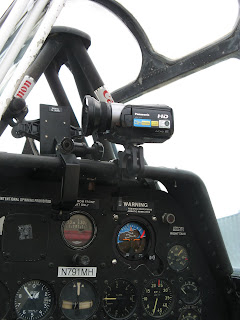
I mounted the camera in the No. 2 (Mark Henley’s) ship on the ramp at Duncan in the morning. Mark has a ball mount already in the aircraft, but it didn’t work for my mount. A couple of other mounting points proved suboptimal because of proximity to the canopy or the placement of the canopy reinforcements. So I mounted it on the dash pointing to the left.
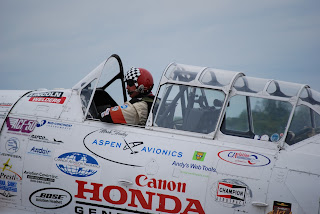
They then moved the aircraft out to onto Runway 13/31 for staging of the performers. I talked security into letting me out to the staging area to turn the camera on just before the flight and then I recovered the camera after the team came back in. You can see it behind Mark’s head in this shot.
Many thanks to the AeroShell Team for the opportunity to get up close and personal. I also got audio interviews that I’ll be releasing on the show soon.
Formation Acro with the AeroShell Team

This is a regular blog post. If you’re looking for show notes or links to show audio, please check out the other posts.
It took some maneuvering (of the logistical kind), but I got up on a flight with the AeroShell Team yesterday.
The show had apparently nixed all non-balloon media rides that required the show to pay for gas. And, being that that includes all non-balloon media rides, it was looking like a dry year at Battle Creek. But not to worry. Capt Force made phone calls and checked in with the FBO and arranged to come out of pocket for 16 gallons of 100LL for the lead T-6.

I launched with Brian Regan at around 4:00. We were going to do a one-ship flight so I could get a sense of that the T-6A’s granddaddy is like to fly. I was a little blue because I was looking forward to being in a four-ship flight, but that’s okay.
But, after a little maneuvering, we got the No. 2 ship, right wing Mark Henley, on the radio. Mark was inbound to arrive at the show and he joined up with us for a couple of maneuvers before heading back to the airport.

I’m also heading over this morning after the briefing to see if they’ll fly a camera during the actual show today.
I’ll be doing a video episode featuring this material and you can probably expect to see it on WGVU-TV in western Michigan when its documentary on this year’s show comes out.
Off to volunteer with CAP for the day and then it’s back to the Airspeed patio for some more writing and editing tomorrow.
Hometown Hero Vince Vaden Gets a Thunderbird Ride
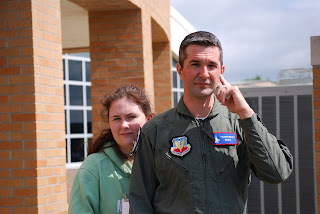
This is a regular blog post. Please check out the other posts for show notes and links to show audio.
Vince Vaden probably didn’t think about what it was like to try to breathe with a refrigerator on his chest unless it was to empathize with a victim of an accident or fire that he might rescue. He probably didn’t think a lot about jet fuel, either, unless it was as part of his hazardous materials and disaster management training.
That’s because Vince is a critical care paramedic and certified firefighter. Most of the time, he’s thinking about other people instead of himself.
But today, Vince got to think about pulling G-loads similar to having a refrigerator on his chest or burning thousands of pounds of JP-8. He got a ride with the United States Air Force Air Demonstration Squadron, the Thunderbirds.
Vince was nominated and selected as a Hometown Hero and given the opportunity to go fly a one-hour demo with LtCol Derek Routt, Thunderbird 7.

Vince started out as a first responder by earning his EMT-Basic license. He became a paramedic just two years later. From 1999 to 2004, he also served as a firefighter for LeRoy Township near Battle Creek.
He’s now a critical care paramedic, which is the top of the paramedic ladder. He’s qualified to transport critically ill and injured people between hospitals, frequently as the highest medically-qualified person on the transport mission.
The Thunderbirds’ Hometown Hero program complements the Thunderbirds’ existing media flight program in raising public awareness of the Air Force’s capabilities while also giving back to the individuals who patiently and quietly protect and take care of us all over the country. The program showcases American people who do amazing things in their communities, bust as the airmen of the US Air Force to amazing things in the skies at shows like the Battle Creek Field of Flight Airshow and Balloon Festival.
They were out on the ramp for the arrival of the team and I talked to Vince briefly. He said the kinds of things that I would imagine I said when I was in his boots (perhaps even the very same boots) and seemed pretty preoccupied with realizing the dream.
I had to leave to get to the balloon gathering to see if there was going to be a launch. They scrubbed it, probably for both low ceilings and wind. I had a feeling that they might scrub it, but wanted to get back to see about available media slots and maybe see Dave Emmert, who took me up in 2006.
At about 6:30, Thunderbird 7 roared down Runway 23 and took to the sky. Because of the low cloud layer, they didn’t do the vertical pull at the end of the runway, instead lifting off and making a tight right turn, entering the clouds level and climbing north for the Hersey MOA near Big Rapids.
Congratulations, Vince! It was good to meet you. And it’s good to know that the Thunderbirds have recognized your patient and skillful service. And that you’re an inspiration to first responders and others who serve everywhere.
Like Vince’s nomination letter says: “The number of lives he has saved is measurable, but the number of lives that he has touched and will continue to touch is limitless.”
Hope you enjoyed your flight, man! Smoke on!
